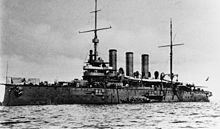SMS Emperor Karl VI.
|
SMS Emperor Karl VI.
|
||||||||||||||||||
|
||||||||||||||||||
|
||||||||||||||||||
|
||||||||||||||||||
|
||||||||||||||||||
SMS Emperor Karl VI. was an armored cruiser of the kuk Kriegsmarine . The ship completed a long mission abroad at the beginning of its career and was then used in the First World War. After the war, the ship was scrapped. The cruiser was named after the ruler Charles VI. named.
Building history
It was not until just five years after the type ship that the second ship of this class was put on the pile on July 1, 1896 at the STT (Stabilimento Tecnico Triestino) San Rocco shipyard in Trieste . The shipbuilding chief engineer J. Kellner was responsible for the design. With the ship (project name: Rammkreuzer D) he had created a modern 6,000 ts ship with sufficient belt armor. The engineer Siegfried Popper from Prague was already involved here , who was to put his stamp on the other new buildings of the Austro-Hungarian Navy. The price for the new building was 11 million crowns , an amount that corresponded to the procurement costs for the two protected cruisers SMS Kaiser Franz Joseph I and SMS Kaiserin Elisabeth together. The heavy artillery supplied by the Krupp company was set up in single-armored and electrically operated turrets . The middle artillery came from Škoda . The ships of this class were intended as a response to the two Italian armored cruisers of the Vettor Pisani class built in 1892-96 and did not need to shy away from comparison, as the latter were only equipped with a 12 × 15 cm main armament. On October 4, 1898, the launch took place and on May 23, 1900 the emperor Karl VI was put into service .
Calls
- 1901: Training trip to the Aegean
- 1902–03: Station ship in East Asia
- 1909: Participation in the international fleet demonstration in the Levant
- 1910: Friendship visit on the occasion of the 100th anniversary of the Republic of Argentina in Buenos Aires
- 1913: On the occasion of the Balkan War, a fleet demonstration off the Montenegrin coast . Securing the evacuation of Scutari .
- 1914: Last training voyage of an Austro-Hungarian warship in peace. Drive to the western Mediterranean
- September 9, 1914: In association with SMS Kaiser Franz Joseph I. Bombardment of the Lovćen batteries
- 1915: Bombardment of the Lovćen batteries
- December 29, 1915: Leaving in association to support the Heligoland group in action .
- 28-29 August 1916: In association, advance to the Italian east coast
- February 1, 1918: The crew takes part in the Cattaro sailors' uprising
- March 19, 1918: Decommissioned in Sebenico
- from March 20, 1918: barracks
Whereabouts
Awarded to Great Britain by an Allied naval delegation in late January 1920 . Then sold to the steelworks Vaccaro & Co. in Italy , towed to Naples and scrapped there.
Technical specifications
- Water displacement: 6,166 ts / 6,863.88 ts max.
- Length: 117.9 m
- Width: 17.27 m
- Draft: 6.26 m
- Drive: 16 Yarrow water tube boilers, 2 standing 4-cylinder 3-way expansion machines , 2 screws
- Power: 12,000 PSi
- Top speed: 20.83 knots
- Armament: 2 × 24 cm L / 40 C / 94 cannons from Krupp in single mounts - 8 × 15 cm L / 40 cannons from Škoda in gun cores - 16 × 47 mm L / 44 SFK - 2 × 47 mm L / 33 SFK - 2 × 45 cm surface torpedo tubes on the side (from June 1917 the two SFK 47 mm L / 33 were replaced by a 7 cm L / 50 anti-aircraft gun).
- Weight of a 24 cm pipe: 28.3 tons
- Weight of a 24 cm breech block: 6.6 tons
- Crew: 570 men
Note: For the sake of authenticity, the place names are given in the spelling of the Imperial and Royal Navy. The links refer to today's conditions.
literature
- Erwin S. Sieche: The cruisers of the k. and k. Navy (= naval arsenal with international naval news and naval overview 27). Podzun-Pallas et al., Wölfersheim-Berstadt et al. 1994, ISBN 3-7909-0506-2 .


